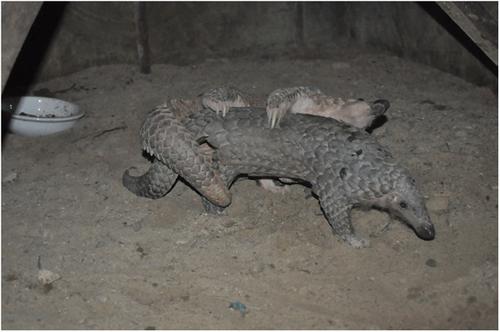Our official English website, www.x-mol.net, welcomes your
feedback! (Note: you will need to create a separate account there.)
Reproductive behavior of the captive Sunda pangolin ( Manis javanica Desmarest, 1822)
Zoo Biology ( IF 1.2 ) Pub Date : 2020-03-01 , DOI: 10.1002/zoo.21526 Fuhua Zhang 1 , Yishuang Yu 1 , Jiaming Yu 1 , Shibao Wu 1 , Shaoshan Li 1 , Qiaoyun Wang 1 , Yue Min 1 , Ruyong Sun 1
Zoo Biology ( IF 1.2 ) Pub Date : 2020-03-01 , DOI: 10.1002/zoo.21526 Fuhua Zhang 1 , Yishuang Yu 1 , Jiaming Yu 1 , Shibao Wu 1 , Shaoshan Li 1 , Qiaoyun Wang 1 , Yue Min 1 , Ruyong Sun 1
Affiliation

|
Understanding reproductive behavior is important for the conservation of endangered species, but research on the reproductive behavior of Sunda pangolins (Manis javanica Desmarest, 1822) is still very scarce. In this study, we used focal animal sampling and all-occurrence recording by an infrared monitor to observe the behaviors of two Sunda pangolins during a 5-day breeding period at the Pangolin Research Base for Artificial Rescue and Conservation Breeding of South China Normal University (PRB-SCNU). The behavioral characteristics and breeding strategies were analyzed, and the results were discussed together with information on other captive Sunda pangolin pairs at PRB-SCNU. The results found that there was no obvious estrus behavior in the captive female, while the male could exhibit sexual excitement and courtship behavior after a brief introduction period. Repeated copulation continued over many days after the female accepted the courtship. The average duration of copulatory behavior was 248.9 ± 148.7 s (n = 25), and all copulation occurred between 20:00 and 08:00 hr in the natural day-night photoperiod. The mating position of Sunda pangolins was lateral-ventral and was classified as the ninth or eleventh pattern under both Dewsbury's and Dixson's classification systems. This study can provide scientific guidance for the captive breeding and management of Sunda pangolins and other pangolin species, which is of great significance for ex situ conservation tactics.
中文翻译:

圈养巽他穿山甲的繁殖行为 (Manis javanica Desmarest, 1822)
了解繁殖行为对于濒危物种的保护很重要,但对巽他穿山甲(Manis javanica Desmarest,1822)繁殖行为的研究仍然非常缺乏。本研究在华南师范大学穿山甲人工抢救与保育繁育研究基地,利用焦点动物采样和红外监测仪全程记录,观察了两只巽他穿山甲在5天的繁殖期内的行为。 PRB-SCNU)。分析了行为特征和繁殖策略,并将结果与 PRB-SCNU 其他圈养巽他穿山甲对的信息一起讨论。结果发现,圈养雌性没有明显的发情行为,而雄性在短暂的介绍后会表现出性兴奋和求爱行为。在雌性接受求爱后,重复交配持续了许多天。交配行为的平均持续时间为 248.9 ± 148.7 s (n = 25),所有交配发生在自然昼夜光周期的 20:00 至 08:00 小时之间。巽他穿山甲的交配位置是侧腹侧,在杜斯伯里和迪克森的分类系统下被归类为第九或第十一模式。本研究可为巽他穿山甲等穿山甲物种的圈养繁育和管理提供科学指导,对迁地保护策略具有重要意义。交配行为的平均持续时间为 248.9 ± 148.7 s (n = 25),所有交配发生在自然昼夜光周期的 20:00 和 08:00 之间。巽他穿山甲的交配位置是侧腹侧,在杜斯伯里和迪克森的分类系统下被归类为第九或第十一模式。本研究可为巽他穿山甲等穿山甲物种的圈养繁育和管理提供科学指导,对迁地保护策略具有重要意义。交配行为的平均持续时间为 248.9 ± 148.7 s (n = 25),所有交配发生在自然昼夜光周期的 20:00 和 08:00 之间。巽他穿山甲的交配位置是侧腹侧,在杜斯伯里和迪克森的分类系统下被归类为第九或第十一模式。本研究可为巽他穿山甲等穿山甲物种的圈养繁育和管理提供科学指导,对迁地保护策略具有重要意义。
更新日期:2020-03-01
中文翻译:

圈养巽他穿山甲的繁殖行为 (Manis javanica Desmarest, 1822)
了解繁殖行为对于濒危物种的保护很重要,但对巽他穿山甲(Manis javanica Desmarest,1822)繁殖行为的研究仍然非常缺乏。本研究在华南师范大学穿山甲人工抢救与保育繁育研究基地,利用焦点动物采样和红外监测仪全程记录,观察了两只巽他穿山甲在5天的繁殖期内的行为。 PRB-SCNU)。分析了行为特征和繁殖策略,并将结果与 PRB-SCNU 其他圈养巽他穿山甲对的信息一起讨论。结果发现,圈养雌性没有明显的发情行为,而雄性在短暂的介绍后会表现出性兴奋和求爱行为。在雌性接受求爱后,重复交配持续了许多天。交配行为的平均持续时间为 248.9 ± 148.7 s (n = 25),所有交配发生在自然昼夜光周期的 20:00 至 08:00 小时之间。巽他穿山甲的交配位置是侧腹侧,在杜斯伯里和迪克森的分类系统下被归类为第九或第十一模式。本研究可为巽他穿山甲等穿山甲物种的圈养繁育和管理提供科学指导,对迁地保护策略具有重要意义。交配行为的平均持续时间为 248.9 ± 148.7 s (n = 25),所有交配发生在自然昼夜光周期的 20:00 和 08:00 之间。巽他穿山甲的交配位置是侧腹侧,在杜斯伯里和迪克森的分类系统下被归类为第九或第十一模式。本研究可为巽他穿山甲等穿山甲物种的圈养繁育和管理提供科学指导,对迁地保护策略具有重要意义。交配行为的平均持续时间为 248.9 ± 148.7 s (n = 25),所有交配发生在自然昼夜光周期的 20:00 和 08:00 之间。巽他穿山甲的交配位置是侧腹侧,在杜斯伯里和迪克森的分类系统下被归类为第九或第十一模式。本研究可为巽他穿山甲等穿山甲物种的圈养繁育和管理提供科学指导,对迁地保护策略具有重要意义。











































 京公网安备 11010802027423号
京公网安备 11010802027423号